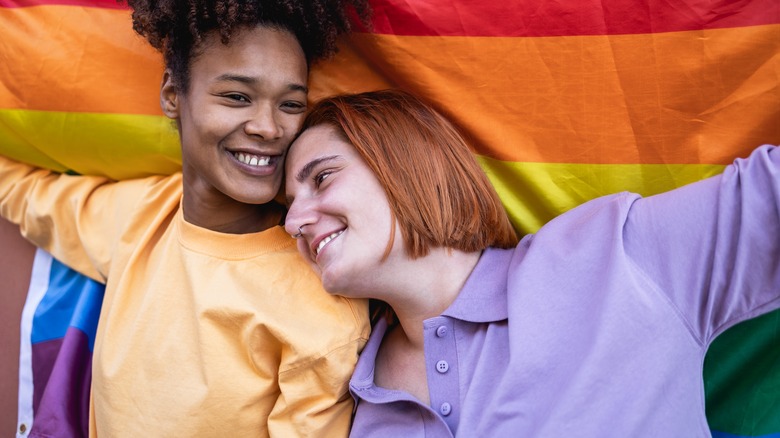What's The Difference Between Being Pansexual And Being Polyamorous?
As a broader and broader spectrum of gender and sexual identities finally find their way into the mainstream, there's a lot for everyone to learn (via UC Davis Health). Many people, including both well-meaning allies and those who identify as LGBTQIA+ themselves, feel a little intimidated by the notion of memorizing each term that is new to them and fear offending someone by confusing one term for another. This is especially true for those who grew up in a world where heterosexuals, homosexuals, and bisexuals were the only recognized sexual orientations. It is important to recognize, however, that other sexualities have always existed and have just only now gained recognition by society. As reported by Them, for instance, the term pansexual first appeared in 1914 in the Journal of Abnormal Psychology.
Two of the most commonly confused perceived sexual orientations — perhaps due to their similar sounding names — are pansexuality and polyamory. To add to the potential mix-ups, polyamory isn't actually even a sexual orientation at all. More confused than ever? The following guide has you covered.
What is (and isn't) pansexuality?
Pansexuality is a sexual orientation defined by sexual or romantic attraction to people based on factors that are not influenced by gender identity or biological sex (via Merriam-Webster). Many pansexual (pan) people refer to themselves as "gender blind" when it comes to who they find themselves feeling attracted to. The basis of their attraction can vary from pan-person to pan-person. One may feel that they are attracted to personalities, another to energy, another to appearance. The only commonality is that they are not attracted to anyone on the basis of their gender or biological sex.
Despite the similarities on the surface, pansexuality is not the same as bisexuality. Bisexual people are attracted to multiple genders on the basis of those respective genders, whereas pansexual people are attracted to none, as detailed by Stonewall. Gender is not a factor whatsoever for a pansexual person. Outspoken pansexual celebrities include Miley Cyrus, Bella Thorne, and Janelle Monaé.
What is (and isn't) polyamory?
Polyamory does not describe a sexual orientation. Instead, it simply refers to the opposite of monogamy. A monogamous person is only interested in being in a romantic relationship with one partner at a time (via Merriam-Webster). A polyamorous person, then, is someone who prefers to engage in multiple romantic relationships with different partners at one time. A person of any sexual orientation can also be polyamorous. In a truly polyamorous relationship dynamic, all partners are aware of the others and fully consent to the arrangement. Each relationship holds emotional value and, in many cases, is viewed as equal to the others.
A polyamorous relationship differs from an open relationship, according to Web MD. In an open relationship, two main partners agree to see other people romantically or sexually outside of the relationship. There is typically an agreement that the new partners will remain secondary to the original partners. In addition, the main partners will often form an agreement that allows or disallows certain physical or sexual acts and emotional involvement levels and may specify whether or not the main partners want to know about the secondary ones. Famous faces representing polyamory include Ezra Miller and Willow Smith.


